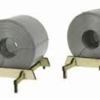As promised, here is a photo of the Weaver coil loads with wooden cribbing.
As you can see, the cribbing is totally unrealistic in appearance. No little legs like those shown are going to hold up 50,000 lbs. coils, let alone 2 of them ![]() . It's hard to fathom, but coils of this size have incredible mass. We're talking about 25 tons.
. It's hard to fathom, but coils of this size have incredible mass. We're talking about 25 tons.
Let me give you an example of a coil's mass. It's 1972 and I'm the crane boy on the end of a tin plating line in Weirton Steel's Tin Mill. I'm at the end of the line. Perpendicular to the end of the plating line is a 50' bay holding a coil field. Overhead cranes traverse the field, picking up coils from the plating lines, moving coils from one end of the building to the other, etc. These are similar to gantry cranes, except that their rails are built into the tops of the building walls. The capacity of these cranes ranged from 60 tons to 300-350 tons. There were usually 3-4 of these in a bay.
One of the most common "hooks" for carrying coils is a device that looks like a 3' yoke with 2 arms hanging down. Each arm has at its end what looks like half an automobile wheel hub (like something you would coil garden hose on). The arms are hinged at the yoke so that they can be swung up and down. As a crane boy, my job is to fit the far arm's hub into the center of the coil with my left hand. I hold it in place using a metal crook. With my right hand, I put the near arm into the hub. I apply pressure on both hubs until the crane operator takes the slack out of hoist cable. Once that happens, both hubs are engaged (the coil is still on the ground), and the coil is safe to move. At that point, my focus is disengaging the metal crook on the far hub and getting out the way (quickly). The crane operator then safely lifts the coil.
So I'm sitting on my stool waiting for the plater to finish a coil. In the meantime I'm watching a crane rapidly bring a coil from one end of the mill to the other. The coil is descending rapidly as well (this guy is in a real hurry). As the coil descends, it collides with a coil on the floor. The force of the collision pops the forward arm out of the coil's center, the coil swings backward until it is facing the floor, and then it falls about 5 feet. I would estimate the coil's weight at between 40,000 and 50,000 lbs. The boom reverberated for about 10 seconds and the entire building shook!
That's what I'm talking about when I say these coils are absolutely massive.
It is also highly unlikely that coils would be shipped as positioned - it would be too easy for them to shift out of these unrealistic cradles when the train starts or stops.
I would think realistic cribbing would look like 6"x6" boards placed several boards deep around the coil and extending to the sides of the gondola. The coils would be shipped with their hollow centers in the direction of travel. Chains would be required; tarps would be optional.
George






